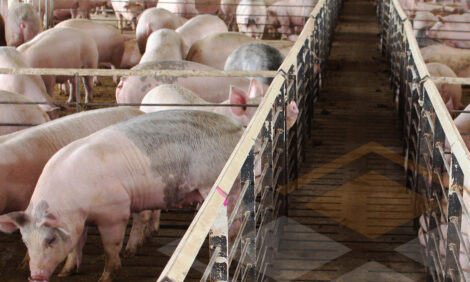



Study Backs Pig Producers' Lost Margin Claims
French pig producers have seen their share of the retail ticket for loin-based retail cuts fade by nearly one-quarter between the years 2000 and 2010, on the basis of figures published by senior French government economist Philippe Chalmin, writes Peter Crosskey.A similar long term decline of around 12 per cent can be observed in slaughterers' share of the retail ticket, while retailers come out with margins that have grown by over 30 per cent.
Chalmin's price monitoring watchdog, the Observatoire de la formation des prix et des marges des produits alimentaires published its latest periodic update in June, just in time for the holiday season. The different sub-committees cover fresh produce, beef, dairy, pork and poultry.
Presenting his findings, Mr Chalmin declared: "There has been a distinct change in the ways agricultural prices are formed, [as part of] the evolution of the CAP, with fewer regulated prices [and a movement] towards market-driven prices. The agricultural world is confronted by a real cultural revolution, which is the shift from the stable to the unstable."
The grinding of gears in the links between farm and consumer have been such that it has been necessary to have some transparency in the way prices are formed, Mr Chalmin told his audience. He is trying to cast light on both agricultural and food prices and disperse some of the impenetrable gloom that cloaks what happens before finished retail products emerge in supermarkets with new-found values.
Whether an archetypal academic will ever break down the retailers' secrecy remains to be seen, but Mr Chalmin has retail margins in his sights. "To be sure, there are still gaps: there are lots of gaps. The first of these has to be the analysis of costs in retailing," he explained. "Retailers remain stuck on gross margins and we haven't had the time yet to move from gross margin to net margin. This will be our top priority in the months to come and will require the good will and cooperation of all the parties."
He has had meetings with the retailers' association, FCD, but the retail sector is playing its cards very close to its chest and being economical with massaged data.
While the government's trading standards agency, DGCCRF, has in the past demonstrated that it is quite capable of seizing 1,200 or so product-level invoices within days when required to investigate specific allegations, the Observatoire has been offered category data by the retailers. Lacking the clout wielded by the finance ministry investigators, Mr Chalmin conceded: "We have yet to engage in the research that we need to do."
| Annual retail price share-out for French loin-based products (chops, escalopes and roasts) |
|||||
|---|---|---|---|---|---|
| Year | Retail Price (€ per kg) |
(1) | (2) | (3) | (4) |
| 2000 | 5.42 | 45.1 | 10.9 | 38.8 | 5.2 |
| 2001 | 6.16 | 45.2 | 8.0 | 41.6 | 5.2 |
| 2002 | 5.74 | 37.4 | 8.6 | 48.7 | 5.2 |
| 2003 | 5.73 | 35.4 | 7.4 | 52.0 | 5.2 |
| 2004 | 5.84 | 37.8 | 7.9 | 49.1 | 5.2 |
| 2005 | 6.05 | 36.9 | 7.4 | 50.5 | 5.2 |
| 2006 | 6.19 | 39.0 | 8.3 | 47.5 | 5.2 |
| 2007 | 6.18 | 35.7 | 8.2 | 50.9 | 5.2 |
| 2008 | 6.42 | 37.7 | 8.3 | 48.8 | 5.2 |
| 2009 | 6.22 | 34.7 | 8.2 | 51.9 | 5.2 |
| 2010 | 6.08 | 35.0 | 8.8 | 51.0 | 5.2 |
| 3-year av. | 6.24 | 35.8 | 8.4 | 50.5 | 5.2 |
| (1) Value of loin liveweight, as % retail price (2) gross margin at slaughter and first butchery, % retail price (3) gross margin at retail, including secondary butchery, % retail price (4) VAT % final retail sale Data: FranceAgrimer-SNM, Kantar WorldPanel Source - FranceAgrimer |
|||||
Even with the limited datasets available to him, Mr Chalmin has already sparked an angry outburst from retailer, Michel-Edouard Leclerc. Writing in his blog (1) a few days later, Mr Leclerc fumed: "Peace never lasts! Pulled up by the agricultural sector over the political inefficacy of his first report, professor Chalmin has sharpened his diagnosis. Now he says that retailers' gross margin has risen and that no-one is quite sure why."
A seasoned publicist, Mr Leclerc was uncomfortable with the unwelcome press attention.
"The media have doubtless not seen Chalmin's sentence saying that more research was needed before indicting the [retail] sector. Without taking time to analyse the body of work, they have declared open season on grocers, in every paper, over the past three days."
The distinctions he makes are strikingly similar to those mentioned by Mr Chalmin: "The problem is that no-one (or very few) make the distinction between 'gross margin' and 'net margin'. Our colleagues in the FCD have tried their best to apply a bit of education." Does this mean that Mr Chalmin will get some of oft-requested net margin data from Mr Leclerc? Probably not.
Mr Leclerc's concern is to restore a tarnished media image. He said: "But the harm is done. In defending oneself against the media, the defendant is automatically in the wrong. It's a waste of time trying to argue under such pressure."
There is even a hint of resignation: "What is more, Philippe Chalmin maintains the suspense. To answer the juicy question which makes editors salivate ('who is trousering what?'), he will publish a further installment of his findings. Three months ahead of the presidential elections?"
Here, of course, Mr Leclerc does not miss a trick. As a good friend of French president Nicolas Sarkozy and, on past occasions, seen alongside the president during supermarket visits, Mr Leclerc's standing is as good as that of, say, the farmers' national union president, Xavier Beulin, at the FNSEA.
The minister who is masterminding President Sarkozy's re-election campaign is none other than food and farming minister, Bruno Le Maire. Mr Leclerc vented his spleen over the minister's reaction to Mr Chalmin's report: "Our farm minister, in the public session of the [National] Assembly, pretending to believe that one could make a 50 per cent margin on a pig, without there being any costs involved in turning it into sausages, ham, roasting joints and pâté..."
For now, most French pig producers would settle for making a profit of any description, let alone 50 per cent. Mr Leclerc, as one retailer among several who appear to make gross profits of around 50 per cent on the most saleable part of a carcass, is left fuming at the politicians.
The French government does, after all, stand to gain from retail VAT returns, Mr Leclerc argues. "So why should they pretend to discover, in the space of just one report, the full extent of the added value that is created by retailers, to cast suspicion on their transparency and their totals. All this is totally hypocritical!" he said.
There is just over a month of the French holiday season to run and then a six-month scramble for the Elysée, with a pause for Christmas and the New Year. It is possible that Mr Chalmin may never see any net margin data that might prove his case. Mr Leclerc, for one, is unlikely to be quite that open-handed.
• A French language summary of the analysis is available online click here.
The full document (only published in French) is also available online click here.
(1) To read Mr Leclerc's blog, click here
Cereal Prices Haunt French Pig IndustryBreton pig producers have seen their earnings slide from over €1.40/kg in April to €1.28/kg on June 27 for basic 56 TMP grade carcasses, according to the Marché du Porc Breton (MPB). As prices continue to hover around €1.28/kg, the MPB economist blames the processing sector for its failure to secure "the necessary few centimes" from the supermarkets. |
July 2011






